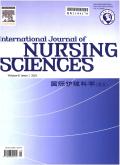中风后吞咽困难恢复的预测因素:系统回顾和荟萃分析
IF 3.1
3区 医学
Q1 NURSING
引用次数: 0
摘要
目的探讨近十年脑卒中后吞咽困难患者康复的影响因素,为护士识别高危患者,制定个性化康复计划,改善患者预后提供循证依据。方法检索中国国家知识基础设施(CNKI)、中国生物医学磁盘(CBMdisc)、中国科学技术期刊(VIP)、万方、PubMed、Embase、CINAHL、Web of Science、Cochrane Library、Scopus等数据库,检索脑卒中后吞咽困难康复预测因素的相关文献。检索期为2013年1月至2023年12月。采用纽卡斯尔-渥太华量表(NOS)和预测模型偏倚风险评估工具(PROBAST)对研究质量进行评估。采用Revman5.3和Stata15.1软件进行meta分析。审查方案已在PROSPERO注册(CRD42024605570)。结果共获得1216条结果,其中英文599条,中文617条。共纳入34项研究,涉及156309例卒中后吞咽困难患者,卒中后1周吞咽困难恢复率从13.53%上升到6个月时的95%。meta分析结果显示,老年患者[OR = 1.06, 95%CI (1.04, 1.08), P <;0.001),低BMI (OR = 1.28, 95% ci (1.17, 1.40), P & lt;0.001),双边中风(OR = 3.10, 95% ci (2.04, 4.72), P & lt;0.001]、较高的美国国立卫生研究院卒中量表(NIHSS)评分[OR = 1.19, 95%CI (1.01, 1.39), P = 0.030]、气管插管[OR = 5.08, 95%CI (1.57, 16.39), P = 0.007]和误吸[OR = 4.70, 95%CI (3.06, 7.20), P <;0.001]是脑卒中后吞咽困难患者吞咽功能恢复的不利因素。结论卒中后吞咽困难的康复评估缺乏标准化的标准,导致吞咽功能的恢复率存在很大的差异。护理人员应对年龄≥70岁、BMI低、双侧卒中、NIHSS评分高的患者、气管插管、误吸等采取针对性预防措施,促进卒中后吞咽困难患者吞咽功能恢复。本文章由计算机程序翻译,如有差异,请以英文原文为准。
Predictors of recovery from dysphagia after stroke: A systematic review and meta-analysis
Objective
This systematic review aimed to identify the predictors of recovery from dysphagia after stroke in the last ten years, thereby providing an evidence-based basis for nurses to identify high-risk patients and develop individualized rehabilitation plans to improve patient prognosis.
Methods
Databases including the China National Knowledge Infrastructure (CNKI), China Biology Medicine disc (CBMdisc), China Science and Technology Journal (VIP), WanFang, PubMed, Embase, CINAHL, Web of Science, the Cochrane Library, and Scopus were retrieved to search for literature on the predictors of recovery from dysphagia after stroke. The retrieval period was from January 2013 to December 2023. The quality of studies was assessed using the Newcastle-Ottawa Scale (NOS) and the Prediction model Risk of Bias Assessment Tool (PROBAST). Meta-analysis was performed using Revman5.3 and Stata15.1 software. The review protocol has been registered with PROSPERO (CRD42024605570).
Results
A total of 1,216 results were obtained, including 599 in English and 617 in Chinese. A total of 34 studies were included, involving 156,309 patients with post-stroke dysphagia, and the rate of dysphagia recovery increased from 13.53% at 1 week to 95% at 6 months after stroke. Meta-analysis results showed that older age [OR = 1.06, 95%CI (1.04, 1.08), P < 0.001], lower BMI [OR = 1.28, 95%CI (1.17, 1.40), P < 0.001], bilateral stroke [OR = 3.10, 95%CI (2.04, 4.72), P < 0.001], higher National Institutes of Health Stroke Scale (NIHSS) score [OR = 1.19, 95%CI (1.01, 1.39), P = 0.030], tracheal intubation [OR = 5.08, 95%CI (1.57, 16.39), P = 0.007] and aspiration [OR = 4.70, 95%CI (3.06, 7.20), P < 0.001] were unfavorable factors for the recovery of swallowing function in patients with post-stroke dysphagia.
Conclusions
The lack of standardized criteria for rehabilitation assessment of post-stroke dysphagia has resulted in reported recovery rates of swallowing function exhibiting wide variability. Nurses should take targeted preventive measures for patients aged ≥70 years, low BMI, bilateral stroke, high NIHSS score, tracheal intubation, and aspiration to promote the recovery of swallowing function in patients with post-stroke dysphagia.
求助全文
通过发布文献求助,成功后即可免费获取论文全文。
去求助
来源期刊

International Journal of Nursing Sciences
Nursing-Nursing (all)
CiteScore
6.10
自引率
2.60%
发文量
408
审稿时长
25 days
期刊介绍:
This journal aims to promote excellence in nursing and health care through the dissemination of the latest, evidence-based, peer-reviewed clinical information and original research, providing an international platform for exchanging knowledge, research findings and nursing practice experience. This journal covers a wide range of nursing topics such as advanced nursing practice, bio-psychosocial issues related to health, cultural perspectives, lifestyle change as a component of health promotion, chronic disease, including end-of-life care, family care giving. IJNSS publishes four issues per year in Jan/Apr/Jul/Oct. IJNSS intended readership includes practicing nurses in all spheres and at all levels who are committed to advancing practice and professional development on the basis of new knowledge and evidence; managers and senior members of the nursing; nurse educators and nursing students etc. IJNSS seeks to enrich insight into clinical need and the implications for nursing intervention and models of service delivery. Contributions are welcomed from other health professions on issues that have a direct impact on nursing practice.
 求助内容:
求助内容: 应助结果提醒方式:
应助结果提醒方式:


